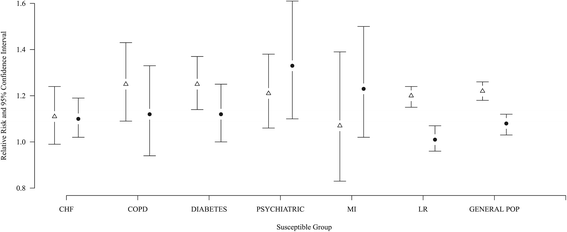The effect of heat waves on mortality in susceptible groups: a cohort study of a mediterranean and a northern European City
- PMID: 25889290
- PMCID: PMC4397690
- DOI: 10.1186/s12940-015-0012-0
The effect of heat waves on mortality in susceptible groups: a cohort study of a mediterranean and a northern European City
Abstract
Background: Climate change is projected to increase the number and intensity of extreme weather events, for example heat waves. Heat waves have adverse health effects, especially for the elderly, since chronic diseases are more frequent in that group than in the population overall. The aim of the study was to investigate mortality during heat waves in an adult population aged 50 years or over, as well as in susceptible subgroups of that population in Rome and Stockholm during the summer periods from 2000 to 2008.
Methods: We collected daily number of deaths occurring between 15th May and 15th September each year for the population above 50 as well as the susceptible subgroups. Heat wave days were defined as two or more days exceeding the city specific 95th percentile of maximum apparent temperature (MAT). The relationship between heat waves and all-cause non-accidental mortality was investigated through time series modelling, adjusting for time trends.
Results: The percent increase in daily mortality during heat waves as compared to normal summer days was, in the 50+ population, 22% (95% Confidence Interval (CI): 18-26%) in Rome and 8% (95% CI: 3-12%) in Stockholm. Subgroup specific increase in mortality in Rome ranged from 7% (95% CI:-17-39%) among survivors of myocardial infarction to 25% in the COPD (95% CI:9-43%) and diabetes (95% CI:14-37%) subgroups. In Stockholm the range was from 10% (95% CI: 2-19%) for congestive heart failure to 33% (95% CI: 10-61%) for the psychiatric subgroup.
Conclusions: Mortality during heat waves increased in both Rome and Stockholm for the 50+ population as well as in the considered subgroups. It should be evaluated if protective measures should be directed towards susceptible groups, rather than the population as a whole.
Figures
References
-
- Field CB. Managing the risks of extreme events and disasters to advance climate change adaptation: special report of the intergovernmental panel on climate change. Cambridge, UK and New York, NY, USA: Cambridge University Press; 2012. - PubMed
Publication types
MeSH terms
LinkOut - more resources
Full Text Sources
Other Literature Sources


